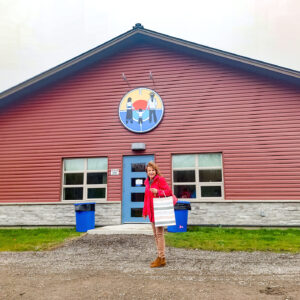
SIX NATIONS – “The world has a problem with waste and I have a solution. It’s as simple as that,” says John Kearns, a pleasant, down to earth man with a friendly smile and a rich Scottish brogue who came from Cape Breton in person to oversee the installation of the Six Nations’ new multimillion-dollar waste disposal system, which he invented and manufactured.
The installation began months ago, but the last pieces of the unit only arrived from Nova Scotia on Friday morning, and were being installed immediately after being off-loaded.
The unit is being installed beside the building that was erected to house a previous incinerator, which Six Nations paid millions for, but which never came to fruition. That fiasco, which cost the community a lot of money and earned Elected Chief Bill Montour and his council a political black eye, ended with the British Columbia supplier going broke before delivery of most of the important pieces, leaving Six Nations holding the bag.
That fiasco has made people very skeptical of Kearns’ disintegrator technology, and he knows it, which is part of the reason he has come to Six Nations to oversee the installation and the initial test running of the unit.
The unit now being pieced together is not the unit Six Nations will ultimately receive.
It is a loaner, so to speak. Upon approval, the real one will be built especially for Six Nations, but in the meantime, Kearns agreed to bring the “loaner” to the landfill site and get it operating to ensure that it lives up to the claims of the inventor.
“The plan is, I am doing a waste site audit of the garbage that comes in here while we are putting it (the disintegrator) together. Then we are going to let them use this unit,” says Kearns.
Kearns insists his invention is not an incinerator at all, but rather a disintegrator.
He explains the difference. “I have designed this machine with the destructive criteria for every known carcinogen-bearing matter, excluding radioactive,” he says. “Pretty well anything can safely go in there.”
He explains that with an incinerator, there is a process, which douses the burning residue ash as it is eliminated. This in itself creates a certain amount of toxicity. But with Kearns’ disintegrator, it burns much hotter and much cleaner and does not require this step in the process. “With this system, we have never found any toxicity in our ash,” he claims. “We are allowed 10,000 parts per million of carbon in the ash. This system delivers 0.03 parts.
That’s 250,000 times cleaner. At the chimney stack, we are allowed 300 parts per million of THC’s, but this one runs at 0.00.”
His new technology is both a blessing and a curse for Kearns, who has been in a 27-year battle with various governing agencies who insist his invention must have an expensive, but Kearns argues unnecessary, quench tank system.
“They wouldn’t give me a permit to operate because I don’t conform,” says Kearns. “They said that every incinerator has to have a quench tank to put the ash out. But I said, this is not an incinerator – it’s a disintegrator, which is a new and different technology.
With this, the ash comes out hot, but not burning and doesn’t require dousing, and the ash is completely inert.”
He has had other bites on his disintegrator, but as he explains it, either potential clients have no money to spend, or they want to deal through a middleman, which drives the cost up, or they are already committed to other technologies, either by contract or under-the-table handshakes in this very lucrative business of waste management.

That is one reason why dealing with Six Nations and targeting other reserves rather than mainstream municipalities makes sense to him. There are not as many hoops to jump through or hands to lubricate along the way.
But in this case there is another reason as well. “Years ago, Chief Montour and I met when he was Regional Director General of Indian Affairs, in Amherst,” Kearns recalls. “I told him at that time what I was doing. He brought down a number of representatives from Aboriginal communities from Nova Scotia to see it. Then when time came for him to do something here, he got me into it again and some of the Band Councillors came and saw the machine in operation. They liked it, but decided to go with someone else, I don’t know why.” After that deal went bad, Montour called Kearns again.
Kearns believes the strength of his disintegrator is not in its complexity. “It is very cost effective and relatively small,” he says. “But the real strength of this new disintegrator technology is in its simplicity. It is based on four natural phenomena—gravity, angle of repose, positive pressure displacement and symmetric balance.”
For the system to be most effective, it needs to run almost continually, which means it will eat up a lot of garbage at minimal cost.
The fact is, the landfill is full at Six Nations, which is why it is so necessary to put something in place as soon as possible to deal with Six Nations waste. But Kearns claims that this machine will not only dispose of new waste, but also can remediate the existing landfill by exhuming garbage and burning it with proportionate blending with new waste.
Another advantage of this system is the fact that even toxic waste is not an issue.
“It will handle, without danger, any toxins and make them inert,” Kearns promises. “We have tested it with everything except radioactive materials. We have even disposed of bombs for the RCMP and bullets and flares. It is designed to accommodate extreme explosive conditions, which is 15 pounds per square inch.”
The unit has a life expectancy of 40 years, with regular maintenance, and it only requires two people per shift to run it. At full capacity, it can accommodate up to 100 tons a day.
Will the new disintegrator live up to the high claims of its inventor? The proof will be in the pudding, and that pudding should be done in about two or three weeks when they fire it up for the first time.









Comments are closed.